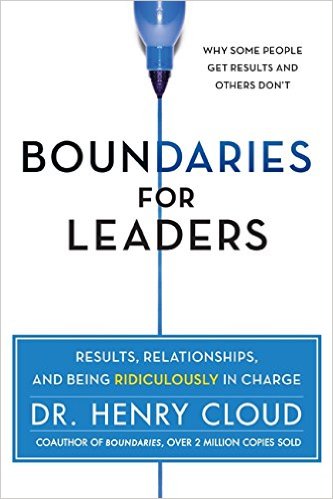Click here to return to Blog Post Intro
Boundaries for Leaders: Results, Relationships, and Being Ridiculously in Charge by Dr. Henry Cloud

Ultimately, leaders define and create boundaries that form team identity and organization culture. Leader, you make it happen:
- For Yourself: Ask, what do I do now to ensure I focus on what is most important? Have I defined it? How do I prevent myself from being pulled into unimportant activities?
- For Your Team: What structures and processes do I have in place to make sure my team is attending to what is crucial? Do they know what that is, and are they aligned? In what areas is the team distracted from the main thing?
- For Your Direct Reports: If I interviewed my direct reports, would they be able to say that I help them to focus on the things that drive results? Do I keep distractions, conflicting goals, or destructive elements from interfering with their attention?
- For the Culture: Am I proactively deciding what the key elements of our culture are going to be? Do those elements drive the attainment of the vision? Are there ways that I keep them front and center so that they are attended to? What exists right now in the culture that either slows down or prevents the vision from happening?
The cold, hard scientific facts are that your team members think and perform better when they are not stressed, afraid, or depressed. Unfortunately, many leaders do not put a lot of thought into creating a positive emotional climate for their people, and sometimes they create the exact opposite. As a result of their leadership, they create stress, fear, and sometimes even depression.
It may not be obvious, but the “caring, people-oriented leader” who has no boundaries creates as much stress as the tyrant…just of a different kind. When you let your people and teams flounder without clear expectations, you are not helping their emotional brains. Research shows that one of the key ingredients of successful group behavior is having “clear expectations” for the group. Setting goals with team members is a good way to do that. Interestingly, social psychology research has shown that when people assign a specific time and place for completion of specific tasks and goals, their chances of success increase by up to 300 percent!
The lesson for leaders is clear: focus your people on what they have control of that directly affects the desired outcomes of your organization. When you do that, two powerful things happen: (1) Results; and (2) Brains function better and get even more results, in a spiraling, upward direction.
And recognize that the higher you go in leadership, the fewer external forces act upon you and dictate your focus, energy, and direction. Instead you set the terms of engagement and direct your own path, with only the reality of results to push against you. So, how are you leading yourself? Too many times, leaders—in the absence of someone looking over their shoulder—allow the reality of the mission or the circumstances to lead and to shape them. They get into a reactive mode, always responding to external forces and problems, and quickly losing sight of their larger role and purpose. The crush of urgent crises, to-do lists, squeaky-wheel people, and distracting details takes over. It can feel very much like it is a war “out there” that requires shooting and ducking every waking hour of every day. In this flurry of activity, too many leaders forget that they also need to manage themselves, since no one else is doing it; they fail to put into place key boundaries of self-leadership that the sheer volume of work and responsibilities can obscure.
If you find yourself relating to this scenario, stop today…practice some stress-relief techniques that work for you. And define boundaries for yourself, your team, and your organization that will help you shoot for the stars!
For me, one of my boundaries is to protect time with family. This Easter, we will celebrate with my brother’s family, so there won’t be an Easter weekend post!
If you’re feeling stressed, always remember…


